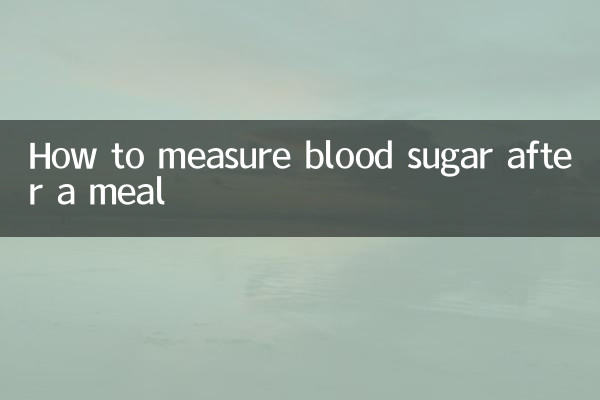How to measure blood sugar after a meal
In recent years, as the incidence of diabetes has increased year by year, postprandial blood glucose monitoring has become an important part of the daily management of diabetic patients. This article will combine the hot topics and hot content on the Internet in the past 10 days to provide you with a detailed introduction to the measurement methods, precautions and related data of postprandial blood sugar to help you better master this health management skill.
1. Why should we measure postprandial blood sugar?

Postprandial Blood Glucose (PPG) refers to the blood sugar level 2 hours after eating. It reflects the effect of food on blood sugar and the regulatory ability of insulin. Compared with fasting blood sugar, postprandial blood sugar can better detect the risk of diabetes early, especially in people with prediabetes. The following is a hot discussion on the importance of postprandial blood sugar on the Internet in the past 10 days:
| keywords | Search volume (times) | Popular platforms |
|---|---|---|
| Postprandial blood sugar meaning | 12,500 | Baidu, Zhihu |
| Early screening for diabetes | 8,900 | Weibo, Douyin |
| Postprandial blood glucose vs fasting blood glucose | 6,300 | Xiaohongshu, Bilibili |
2. Steps for measuring postprandial blood sugar
The following are the most popular post-meal blood sugar measurement methods on the Internet in the past 10 days, compiled based on the advice of professional doctors:
1.Preparation tools: Blood glucose meter, test strips, blood collection needles, alcohol swabs.
2.Measurement time: Start timing from the first bite of meal and measure after 2 hours.
3.clean hands: Wash your hands with warm water and dry them, or use alcohol pads to disinfect your fingertips.
4.Collect blood: Use a blood collection needle to prick the side of your fingertip and take a drop of blood.
5.reading: Touch the blood drop to the test strip and wait for the blood glucose meter to display the result.
The following are common questions recently asked by netizens about measurement steps:
| question | frequency of occurrence | answer |
|---|---|---|
| Does 2 hours after a meal start or end with eating? | 85% | Start timing from the first bite of food |
| Which part of fingertip blood sampling is the least painful? | 72% | The pain on the sides of the fingers is less severe than the finger pads |
| Do I need to stop taking medication before measurement? | 68% | Take your medication as normal, no need to stop taking it |
3. Normal range and abnormal interpretation of postprandial blood sugar
According to the latest "China Type 2 Diabetes Prevention and Treatment Guidelines", the normal range of postprandial blood sugar is as follows:
| crowd | Normal value (mmol/L) | Abnormal value (mmol/L) |
|---|---|---|
| healthy people | <7.8 | ≥7.8 |
| prediabetes | 7.8-11.0 | ≥11.1 |
| diabetics | individualized goals | Exceeded goals set by doctors |
4. Practical suggestions for lowering postprandial blood sugar
Combining the hot health topics discussed on the Internet in the past 10 days, the following methods have been proven to be effective in controlling postprandial blood sugar:
1.diet modification: Choose low GI foods such as whole grains and green leafy vegetables.
2.exercise intervention: Walking for 20-30 minutes after a meal can significantly reduce blood sugar spikes.
3.Eating order: Eat vegetables first, protein next, and staple food last.
4.Hydration: Drinking 500ml of water before meals can help delay sugar absorption.
Recent popular dietary advice data are as follows:
| food category | Recommendation index | Things to note |
|---|---|---|
| oat | ★★★★★ | Choose whole oats, avoid ready-to-eat types |
| apple | ★★★★☆ | Eat it with the skin, limit it to half at a time |
| nut | ★★★☆☆ | No more than 30 grams per day |
5. Common misunderstandings and truths
Based on the health rumor-refuting hot spots in the past 10 days, the following common misunderstandings about postprandial blood sugar have been sorted out:
1.Misunderstanding: "Don't drink water before measuring blood sugar" -the truth: Plain water does not affect the results, but sugary drinks can distort the data.
2.Misunderstanding: "It doesn't matter if it exceeds the standard occasionally" -the truth: A single exceedance should be recorded, and continuous exceedances should seek medical treatment.
3.Misunderstanding: "Only diabetics need to be tested" -the truth: Regular monitoring is recommended for people over 40 years old.
Mastering the correct post-meal blood sugar measurement method, regular monitoring, and scientific lifestyle intervention are important means to prevent and manage diabetes. If you have persistently abnormal post-meal blood sugar levels, please consult a professional doctor promptly.

check the details

check the details